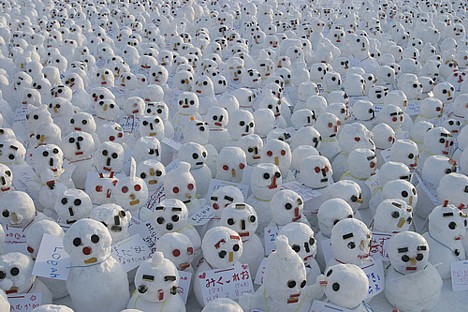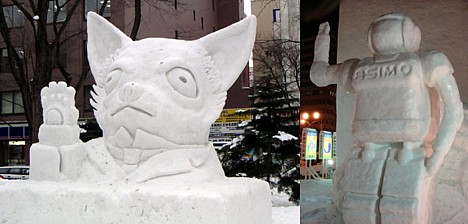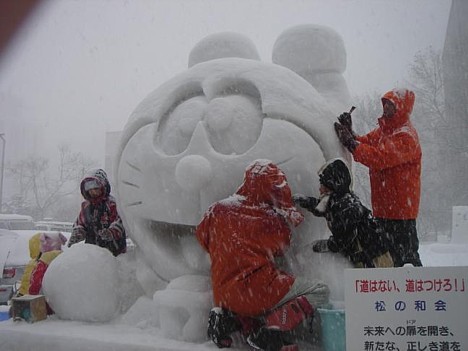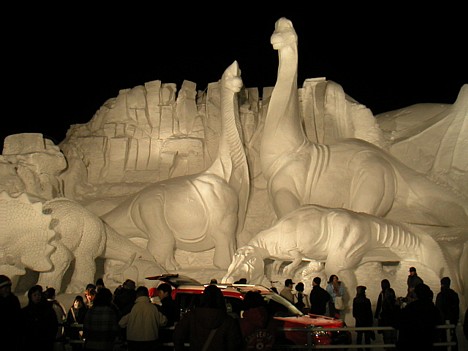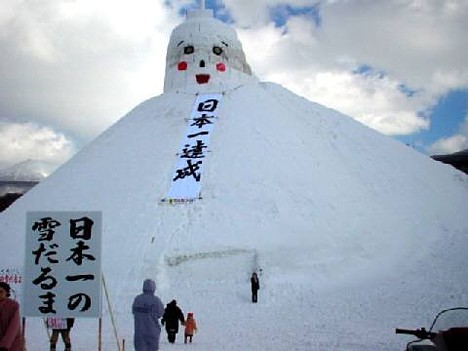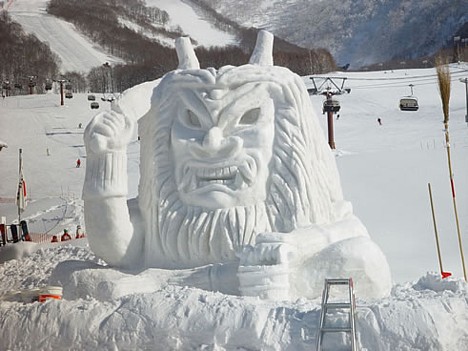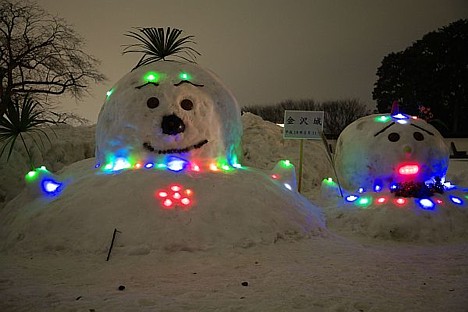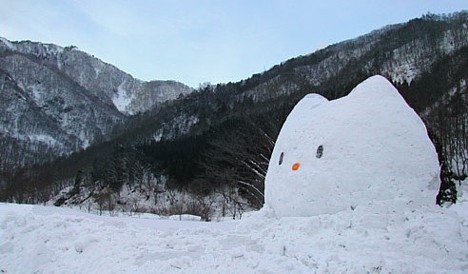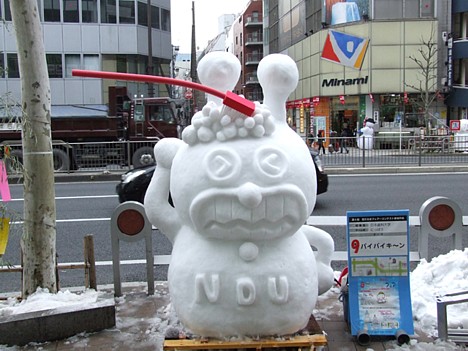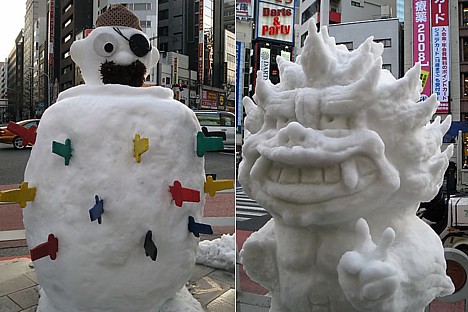In the sophisticated popular culture of the Edo period (1603-1868), much attention was devoted to Japan's rich pantheon of traditional monsters and apparitions, known as yokai. Sometimes frightening, sometimes humorous, these compelling Japanese folk creatures were the subject of numerous artistic and literary works. One such work was Hyakkai Zukan, a collection of picture scrolls completed in 1737 by Sawaki Suushi, a relatively unknown artist who studied under master painter Hanabusa Itcho (1702-1772). Hyakkai Zukan's colorful depictions of Japan's most notorious creatures inspired (and were copied by) yokai artists for generations. Here is a peek inside.
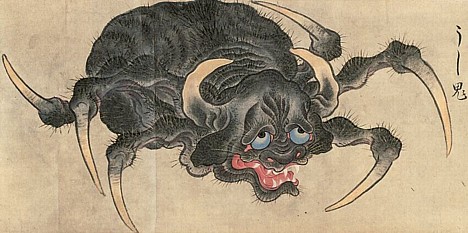
Ushi-oni [Enlarge]
Ushi-oni (lit. "cow devil") is a malevolent sea monster with the head of a bull and the body of a giant spider or crab. It is most often encountered in the coastal waters of western Japan, particularly in Shimane prefecture, where it is feared for its vicious attacks on fishermen. [More]
Ushi-oni is usually seen in connection with a related monster, called Nure-onna.
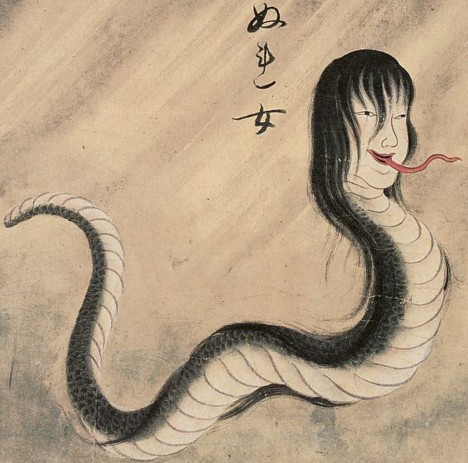
Nure-onna
Nure-onna (lit. "wet woman") is a fast-swimming amphibious creature with the head of a human female and the body of a gigantic snake. Her appearance varies slightly from story to story, but she is usually described as having beady, snake-like eyes and long, sharp claws and fangs. Nure-onna is typically seen at the water's edge, washing her long, flowing hair. In some stories, she carries a small child, which she uses to attract potential victims. When a well-intentioned person offers to hold the baby for Nure-onna, the child attaches itself to the victim's hands and grows heavy, making it nearly impossible to flee. In some stories, Nure-onna uses her long, powerful tongue to suck all the blood from her victim's body. [More]
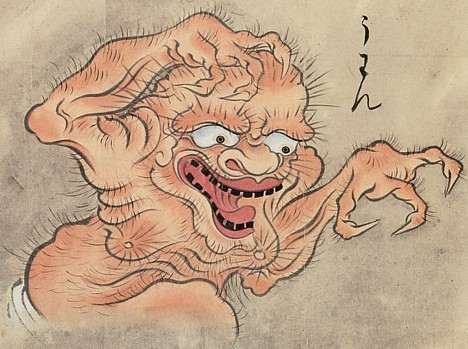
Uwan
In ancient Aomori prefecture legends, Uwan is a disembodied voice that inhabits old, abandoned temples and homes. When a person enters a haunted building, the formless spirit belts out an ear-piercing "Uwan!" (hence the name). The voice is only audible to people inside the building -- those standing outside hear nothing. Uwan consists only of sound and poses no physical danger.
Ancient Japanese legends are rife with examples of formless yokai like Uwan, which consist of nothing but sound, light or other natural phenomena. In the Edo period, however, these yokai assumed physical bodies as artists incorporated them into their work.
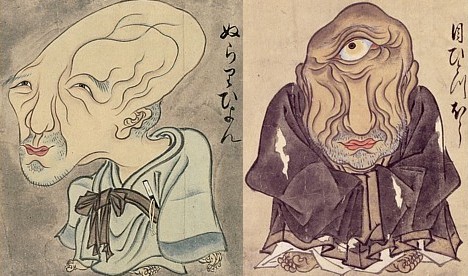
Nurarihyon (left), Mehitotsubou (right)
Another yokai that got a facelift in the Edo period is Nurarihyon, pictured here as as a well-dressed old man with an elongated bald head. Ancient Okayama prefecture legends describe Nurarihyon (lit. "slippery strange") as a marine creature found in the Seto Inland Sea, often seen bobbing around on the surface of the water like some sort of giant jellyfish or octopus. Nurarihyon eludes capture by diving underwater when people approach to investigate.
In the Edo period, Nurarihyon came to be known as a mysterious old man with the uncanny ability to sneak into homes and "take over." When the residents of a home encounter him sitting around drinking tea, they are unable throw him out and cannot help but treat him as the head of the household. Nurarihyon is said to be a highly respected figure in the world of yokai.
Mehitotsubou (above right), a large monk with a cyclopean eye, is a variant of the large shape-shifting monks commonly found in Japanese folk tales.
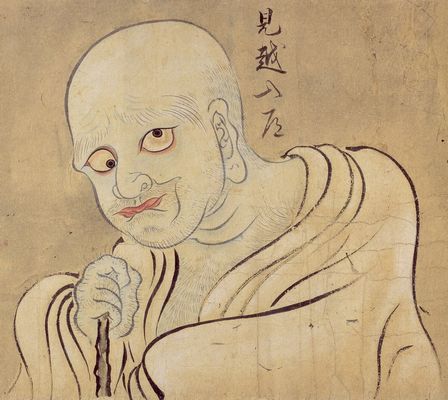
Mikoshi-nyudo
Another monster monk is Mikoshi-nyudo (a.k.a. Miage-nyudo), a large, cross-eyed mendicant encountered on mountain passes or on lonely roads at night. Mikoshi-nyudo grows taller when you look up at him -- and the higher you look, the taller he grows. Look up for too long and you will die, goes the legend, but say "mikoshita" ("I see higher") and he disappears. Mikoshi-nyudo's true identity is unknown, but in some areas he is believed to be a shape-shifting weasel, fox or tanuki.
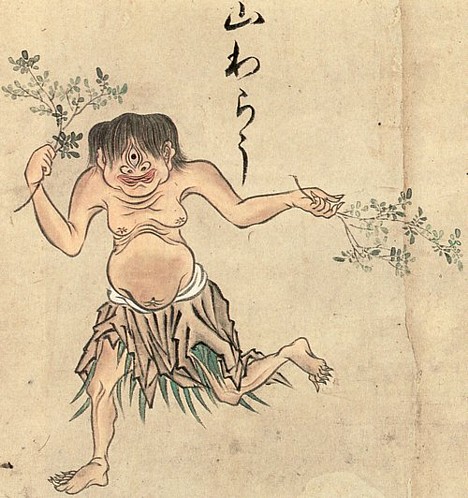
Yama-warau
Yama-warau (a.k.a. Yama-waro) are hairy, one-eyed Garappa (a variety of Kappa found in Kumamoto prefecture) who have gone into the mountains for the winter. These child-sized creatures are known to provide assistance to lumberjacks in the mountains, and they eagerly return again and again to help, as long as they are rewarded with liquor and rice balls.
Like other varieties of Kappa, Yama-warau are fond of playing tricks on people, and they enjoy sumo wrestling. They sometimes break into people's homes to take a bath, and they have a sixth sense for danger, which allows them to escape from people with evil intentions.
At the spring equinox, Yama-warau return to the rivers to live as Garappa. They travel in groups, jumping from one rooftop to the next, all the way down to the water. If, along the way, they come across a new home under construction, they get angry and poke holes in the walls. Legend has it that anyone who goes to the river to catch a glimpse of a returning Yama-warau will become sick.
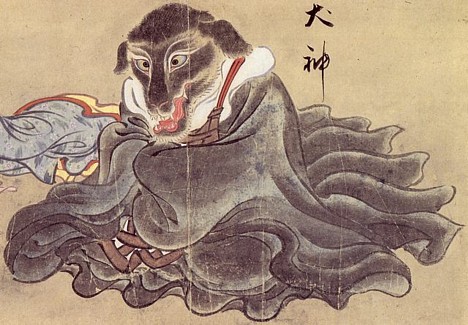
Inugami
An Inugami (lit. "dog god") is a familiar spirit that looks like a dog and acts as a protective guardian. Inugami are extremely powerful and loyal, and they are known to carry out acts of revenge on behalf of their "owners." They can also exist independently, and under some circumstances they may turn against their owners. Inugami also have the ability to possess humans. [More]
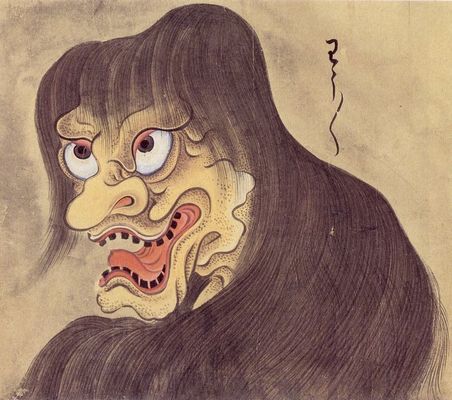
Ouni
Ouni is a mountain hag with a mouth stretching from ear to ear and a thick coat of long, black hair covering her entire body. According to an old Niigata prefecture legend, Ouni appeared one day to a group of women as they were spinning hemp into yarn. After accepting the hairy hag's offer to help, the women watched in surprise as she repeatedly placed raw hemp fiber into her mouth and pulled out finished yarn. After quickly producing a large quantity in this way, Ouni stepped outside and suddenly disappeared. Legend has it that she left footprints in the nearby rocks, which can still be seen to this day.
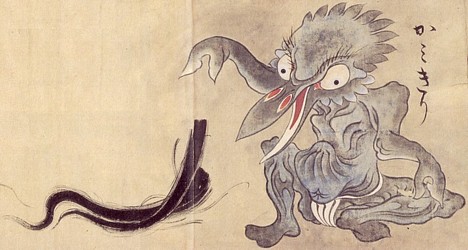
Kami-kiri [Enlarge]
Kami-kiri (lit. "hair-cutter") are ghostly spirits known for sneaking up on people and cutting all their hair off, particularly when they are unknowingly engaged to marry a yokai, spirit or other supernatural creature posing as a human. These hair-cutting attacks are intended to delay or prevent weddings between humans and otherworldly beings, which are typically doomed to failure. [More]
For more images from Hyakkai Zukkan, see the Sawaki Suushi collection at Wikipedia Commons.
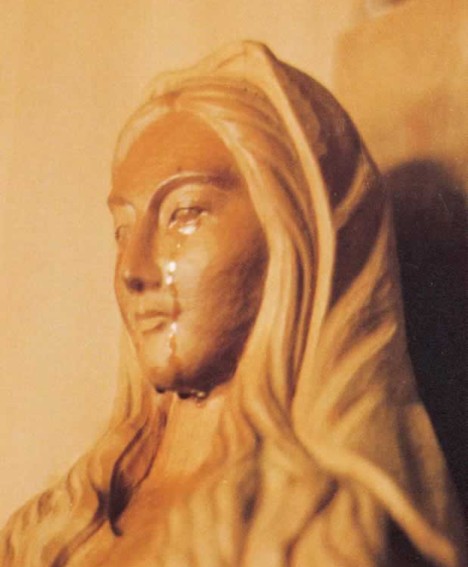

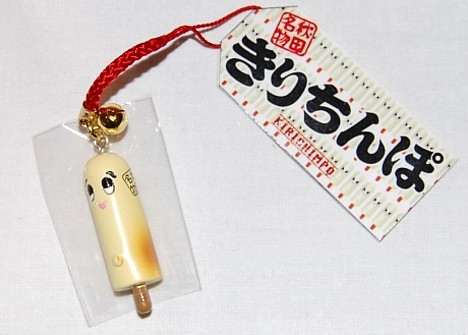
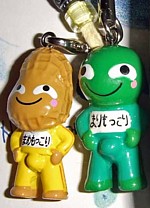 The company came up with the idea for Kirichimpo last year after witnessing the far-reaching success of Marimokkori, a happy, well-endowed green monster mascot from Hokkaido, whose name is a play on the words marimo (a type of giant algae ball found in Lake Akan) and mokkori ("erection"). Marimokkori's popularity extends far beyond Hokkaido's shores, to as far away as Chiba, the home of his younger peanut-headed cousin named Mamemokkori (mame means "bean"), and Tokyo, where mounds of the popular Marimokkori can be found inside UFO Catcher claw vending machines at game centers.
The company came up with the idea for Kirichimpo last year after witnessing the far-reaching success of Marimokkori, a happy, well-endowed green monster mascot from Hokkaido, whose name is a play on the words marimo (a type of giant algae ball found in Lake Akan) and mokkori ("erection"). Marimokkori's popularity extends far beyond Hokkaido's shores, to as far away as Chiba, the home of his younger peanut-headed cousin named Mamemokkori (mame means "bean"), and Tokyo, where mounds of the popular Marimokkori can be found inside UFO Catcher claw vending machines at game centers.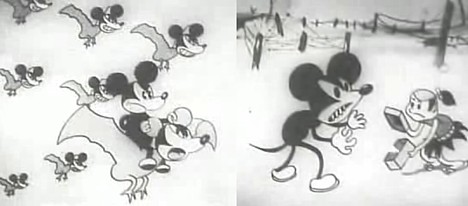









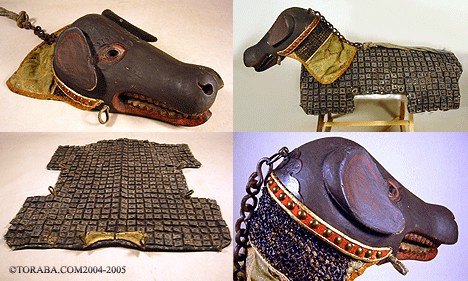
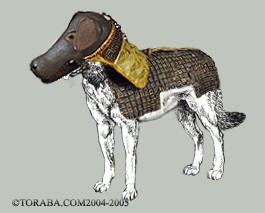
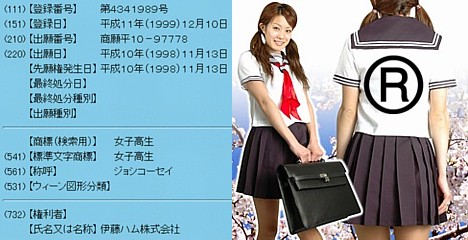
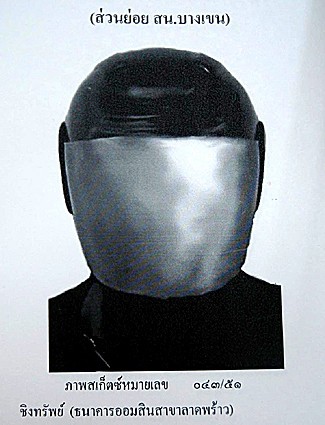
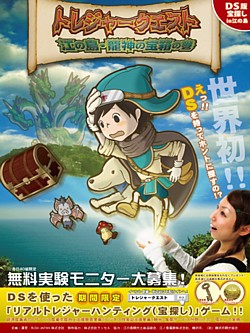 On a small island near Tokyo, people armed with Nintendo DS portable game consoles are scouring the terrain in search of clues that will lead them to a secret treasure. The activity is part of a unique, virtual-meets-real-world game called "Treasure Quest: Enoshima - Treasure of the Dragon," which was developed by Rush Japan, a Tokyo-based company that specializes in planning treasure hunts and tourism-related events.
On a small island near Tokyo, people armed with Nintendo DS portable game consoles are scouring the terrain in search of clues that will lead them to a secret treasure. The activity is part of a unique, virtual-meets-real-world game called "Treasure Quest: Enoshima - Treasure of the Dragon," which was developed by Rush Japan, a Tokyo-based company that specializes in planning treasure hunts and tourism-related events. 